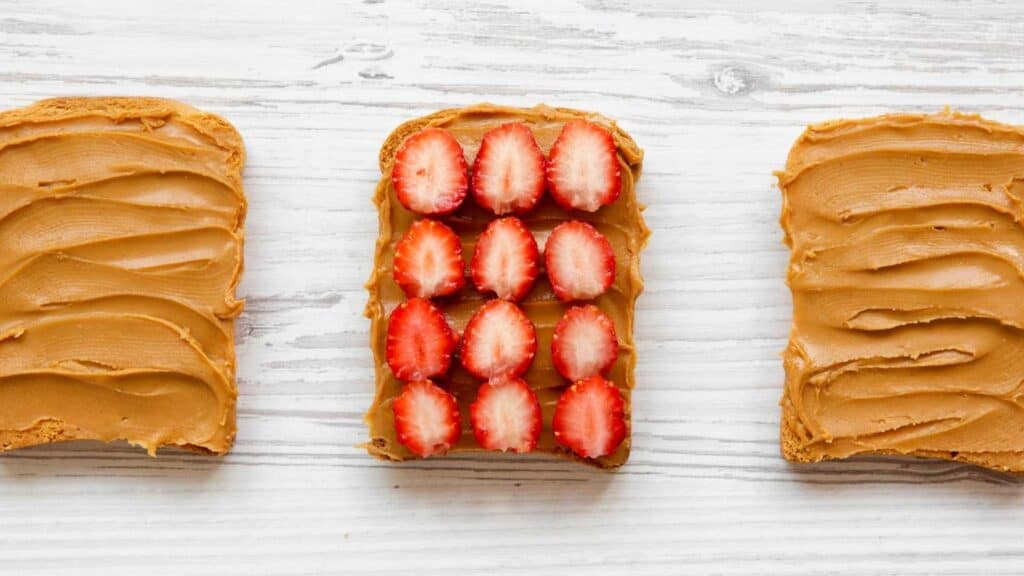When we go through the grocery store we usually see so many different types of peanut butter: the regular stuff from your childhood with lots of ingredients, something called “natural” and then there is the stuff that is labeled “100%” that claims to be peanut butter without palm oil. Which of these is the BEST one? I’m about to give you your answer.
Is Peanut Butter A Healthy Food?
You know I don’t like to label food as healthy or unhealthy. ALL foods fit into our lives! Labeling them as good and bad, and then restricting them, can actually lead to harmful effects of having a poor relationship with food and many other undesired outcomes like binge/overeating eating, increasing our set point weight, and not to mention the mental health toll!

What Macro Nutrients Are In Peanut Butter?
The two main macronutrients in peanut butter are typically fat and protein. There are carbohydrates in smaller amounts, especially if your nut butter has added sugars.
Peanut butter IS a great source of fat which can help keep us full and satisfied as well as help us to absorb some nutrients that are fat soluble. We need fat. Most of the fats in peanuts themselves are what we call monounsaturated fats and poly unsaturated fats- fats that have been shown to have protective health benefits.
Like I mentioned, peanut butter also gives some protein which our muscles love and again helps with satisfaction. To be fair, while peanut butter does give us SOME protein, I think of it more for the fat qualities, since those are much more prominent in the nutritional profile. However, it can be a component of a high protein meal, like when you put some on some whole grain toast and top with flax seeds or when you drizzle on top of yogurt and berries. It helps ADD to the protein. Make sense?

Will Peanut Butter Make You Gain Weight?
Peanut butter is nutrient dense, meaning you get a lot of nutrients, including calories, packed into a small volume. This steers many people away from peanut butter because they’re scared to “over do it” and gain weight with extra calories. The thought that peanut butter is “too high” in calories is a lie. Honestly, nothing is “too high” in calories and the fat leads to helping us to feel full and satisfied. We not only need the fats for our bodies to function optimally, but we deserve to enjoy their deliciousness.
If you’re worried about weight gain, then the problem isn’t the peanut butter it’s the fear of your weight changing. This fear keeps our roots planted in diet culture and our lives lived with food rules that control our eating choices. If you have this fear, checkout this post on how to overcome your fear of weight gain and this one all about the topic of wanting weight loss and intuitive eating.
Why Is There Oil In Peanut Butter?
So, you may have heard, or seen on the label, that oils are added to some peanut butters. What are these oils and what is the purpose of them, anyway? Let’s take a look.
What Are Hydrogenated Oils And Why Are They In Peanut Butter?

Hydrogenated oils are added to some peanut butter varieties to help keep the peanut butter shelf stable since the hydrogenated oils have a hard waxy texture at room temp. Ever notice how you don’t need to stir the traditional JIF or Skippy stuff? The added oil is why. It also helps to preserve the freshness of the peanut butter so it can stay in your pantry without going bad.
Hydrogenation is a chemical process used to convert liquids to solids. Again, why the peanut butter with oil doesn’t separate.
Partially Hydrogenated Oil VS Fully Hydrogenated Oil
There are two types of hydrogenated oils we should touch on: partially hydrogenated and fully hydrogenated. The food industry used to use partially hydrogenated in our foods, which actually has a better melting point than the fully hydrogenated in terms of cooking and food. BUT… we found that the partially hydrogenated oils created trans fats. Trans fats are actually no longer recognized as safe by the FDA because it can negatively effect our cholesterol levels and lead to heart disease. Not good.
SO… the FDA banned the partially hydrogenated kinds. Now, trans fats still occur naturally in small amounts in things like milk, butter, cheese and meats. Think animal products, but it’s in a small amount nothing like what was in the partially hydrogenated oils.
The fully hydrogenated stuff, on the other hand, doesn’t have as great of a melting profile, but food scientists are able to combine it with non-hydrogenated oils to get the desired outcome for you creamy dreamy, shelf stable peanut butter.
You might see these marked as “trans fat free”. That’s because they used to make peanut butter with partially hydrogenated oils, which do contain trans fats.
Is There a Downside to Peanut Butter With Oil?

Now the “issue” that arises here is that these fully hydrogenated oils contain saturated fats. Saturated fats could also negatively impact our cholesterol and increase risk of heart disease. Think of the blood flowing through you getting “gunked” up by hard waxy stuff so it doesn’t flow as easily. The recommendation is to keep sat fat to roughly 13g per day. Now, to be honest, I don’t recommend you go counting this stuff. If you have a well rounded diet with fruits, veggies, etc. even if you enjoy some Oreos or ice cream, you’ll still be fine. It’s the big picture.
I’m not a fan of food fear, you guys know that!
I truly believe that our bodies WILL guide us towards the well rounded diet, if we listen to them. That has got to be the biggest fear of those who are wanting food freedom from diet culture, “But, I still want to be healthy!” You can, gorgeous. Not sure where to start? Snag a copy of my free e-book, The Ultimate 5 Step Guide To Food Freedom.
Are Hydrogenated Oil and Palm Oil Different?
You might see that many times the peanut butter jars labeled “natural” uses palm oil in place of the hydrogenated oils. Palm oil is natural stable tropical oil, hence “natural peanut butter” so we humans don’t make this oil ourselves like we do the hydrogenated stuff.
The term “natural” is said to mean that nothing on the ingredient list is artificial or synthetic. However, the FDA has not set rule making to establish a definition for the term “natural”.
Palm oil does also contribute some saturated fat and, actually, if you look at the labels and they likely have the same amount. So, I wouldn’t necessarily say this is a “healthier” choice.
There are also questions regarding sustainability with palm oil, so many environmental activists aren’t fans.
So, Is Peanut Butter Without Palm Oil Better?

Now a days you can find SO many varieties of peanut butter where ingredient list will legit just say peanuts. Nothing else. There are no added oils (man-made or natural), no added sugar, no added salt. Just. Peanuts.
Peanut butter without palm oil or hydrogenated oils will have less of that saturated fats, and therefore more of those health promoting fats (MUFAS and PUFAS) that we chatted about earlier.
Peanut butter without palm oil DOES taste and feel different than peanut butter with palm oil. It will likely be less sugary, since there is no sugar added if the ingredient list says just peanuts. It will also have a much runnier consistency. Ya know, like those super drippy peanut butter shots you see all over Instagram! Probs using peanut butter without palm oil.
How Do You Know If You Are Buying Peanut Butter Without Palm Oil Or With It?
The best way to know if you’re buying peanut butter without palm or with it is to look at the label.

Do I Recommend Palm Oil Free Peanut Butter?
To be honest with you….. I usually keep peanut butter with palm oil AND peanut butter without palm oil in my pantry. Usually, I like to drizzle peanut butter on oatmeal, smoothies toasts, yogurt, etc and the peanut butter without palm oil (the 100% peanut stuff) has best consistency to do that.
BUT there are other days when I just want to spoon it in my mouth and kinda have it as dessert, so I pick some of peanut butter with palm oil because of the texture and the fact that it is way sweeter because of the sugar. I eat both peanut butters with oil and without. They’re both satisfying to me in different ways and have a time and place.
Saying you can’t ever have peanut butter with palm oil because it doesn’t have any many health benefits is like saying you should never eat a cookie again and only pick a piece of fruit for sweetness, in my opinion. Not realistic, not enjoyable and not going to happen for me.
Is It A Food Rule To Pick The Natural, 100% Peanuts, Peanut Butter?
It’s okay to use some gentle nutrition here. If you’re standing in the aisle and thinking “What do I get?!” if you want to pick the natural because of the benefits to health, go for it. BUT I always say you should NOT have anxiety if you were to have to eat the regular stuff. That signals a food rule. I have a blog post that goes more in depth on the difference that would be super helpful if you want to understand more the difference between a food rule VS food preference.
Can You Over Eat Peanut Butter With Palm Oil?
One thing to note is that when I had food rules I never allowed myself peanut butter at all. I fell into that camp that we talked about of people who thought fat was bad.
When I finally started to find food freedom and I had some, especially the JIF stuff with oil and sugar… I binged. Like, I made a gooood dent in a Costco sized tub.
I don’t believe in fearing food or swearing it off. By doing this you’re setting yourself up for a binge. Your body is like “Wow, I never have this I better stock up!” I think THAT does more harm, let’s be real physically and psychologically, than allowing yourself the peanut butter that you want, when you want.
You’d be shocked at what happens when you give yourself permission to eat ALL foods. I hear this so often in my membership, The SociEATy. Yes, at first you might want to eat more of the previously deemed “bad” foods (for me, the peanut butter), but when your body realizes it can have this food whenever it wants, in any amounts, it won’t drive you to eat it in excess anymore. It will realize “Okay, that doesn’t feel good. Let me adjust my cravings to what does feel good and the amounts that feel good” It’s a crazy thing! But it happens.
I hope this blog post helps you to understand the difference between peanut butter with palm oil and peanut butter without palm oil! Bottom line: health CAN be a factor in your food choices, but it shouldn’t be the ONLY factor. If you want to have yourself some JIF, or Skippy, or whatever brand you love… go for it!
XOXO
-Colleen






Leave a Reply